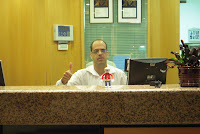 I’ve been in Viet Nam for a week, taking in the sights and struggling with an enormous amount of history that I don’t think that I ever learned. I’ll get back to the sights of the first week later on. We left Hanoi last night on the overnight train, the Fanxipan Express, to Lao Cai, a small town on the China border. Hanoi was participating in a Save the Earth program and the lights were dimmed at 8:30pm. We were waiting by the railroad tracks; ready to board the train and it became apparent that there was a problem. Our car was missing. Wait long enough and magic happens: a car backs up and attaches itself to the train. We were good to go! There is nothing like riding in the caboose, with your fingers crossed, hoping that the mechanic hooked the last car up correctly!
I’ve been in Viet Nam for a week, taking in the sights and struggling with an enormous amount of history that I don’t think that I ever learned. I’ll get back to the sights of the first week later on. We left Hanoi last night on the overnight train, the Fanxipan Express, to Lao Cai, a small town on the China border. Hanoi was participating in a Save the Earth program and the lights were dimmed at 8:30pm. We were waiting by the railroad tracks; ready to board the train and it became apparent that there was a problem. Our car was missing. Wait long enough and magic happens: a car backs up and attaches itself to the train. We were good to go! There is nothing like riding in the caboose, with your fingers crossed, hoping that the mechanic hooked the last car up correctly!I don’t know when I was last on an overnight train, if ever, but it was cozy and comfortable enough for a few hours sleep. Let me introduce my cabin mates. Penny Goldin is a childhood friend of mine; she and her friend, Jenny Wang are both members of the Moosewood collective in Ithaca, NY. Caroline Chauteau, a French woman living in Amsterdam, is a friend of Jenny’s dating back to a high school exchange program in France. Caroline has traveled often to Viet Nam and was the organizer of this great adventure. That is the cast of characters, in addition to our guide Phung (who was not sharing a cabin with us!)
The train rocked and rolled and chugged along climbing to over 4000ft in elevation during the 8 hour ride. Our arrival in Lao Cai seemed to be the morning alarm for the town. It came alive. A quick breakfast at a local restaurant and we were on our way to the BacHa Market. Although only 40 km away, the drive to BacHa over winding narrow roads with many switchbacks, that climbed another 1000 vertical feet, would take almost 2 hours!

The market, as promised was large and colorful. The Flower Hmong people predominate, and they are friendly, photogenic and persistent saleswoman.




This weekly market is a major gathering place and meals are prepared in addition to everything (fruits, vegetables, spices, tobacco), and anything (tools, wooden yokes for the water buffalo, brooms, and animals). We did our part to support the local economy.

Before leaving town, we stopped at the Hmong Kings House.

Built by the French colonists and Chinese in 1920, it is a beautiful saffron colored building that would fit right in with the mansions in Newport, RI.

The terra cotta roof is very distinctive. The house is vacant at this time, but plans are to develop a hotel at the site.
 We stopped at a Hmong village and the children were thrilled that Phung had treats for them. They love having their pictures taken. The Flower Hmong people are best known for the colorful dress they wear. At this home, the grandmother was eager to join in the photo-op.
We stopped at a Hmong village and the children were thrilled that Phung had treats for them. They love having their pictures taken. The Flower Hmong people are best known for the colorful dress they wear. At this home, the grandmother was eager to join in the photo-op.
We trekked across the rice fields visiting the remote villages of the Black Yao, Nung and Phu La tribes on the way.


The manicured fields and vistas were breathtaking; the shades of green were endless.

We crossed this small bamboo toll bridge, which kept us out of the river and feet dry. The young woman who built the bridge has no problem charging for her efforts.

Did I mention that there are a lot of water buffalo? Mr Bill could not believe the size of this “patty” on the path. I have to admit that it was bigger that any bison deposits that I ever saw in Yellowstone!

At the water’s edge, we took a boat ride down the Chay River.

There were more beautiful vistas and an interesting industry of reclaiming sand from the water for construction.

We backtracked on the same winding road to La Cai and then up a similar winding to SaPa. There was a stark contrast in the dress of the people as we climbed toward SaPa: the Black Hmong, with black skirts and tops and Red Yao, with red triangle scarves covering the women’s heads made up the majority.
We checked into the Bamboo Sappa Hotel; the climb to our 5th floor rooms was worth the view alone!

Unfortunately, the clouds descended from the mountaintop before we were able to enjoy the sunset.
Tomorrow – more trekking and an adventure that continues…







































